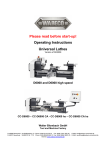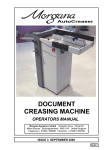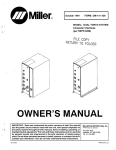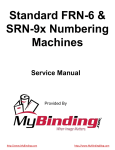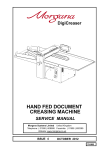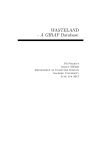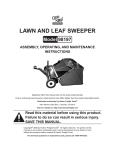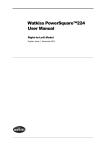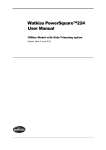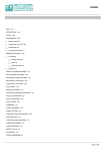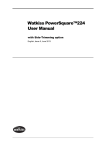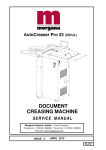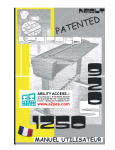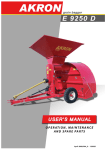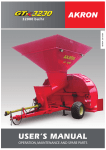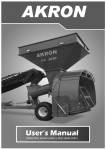Download FOLDING SYSTEM - PrintFinishing.com
Transcript
FOLDING SYSTEM SERVICE MANUAL Morgana Systems Limited Snowdon Drive WinterHill Milton Keynes Buckinghamshire MK6 1AP United Kingdom Telephone: ( 0908 ) 608888 Facsimile: ISSUE 2 MARCH 2002 625-030 INTRODUCTION SERVICE FOLDING SYSTEMS i ...........Introduction The purpose of this manual is to explain the procedure for dismantling and re-assembly of the major assemblies on both the Folding and Cross Folding machines. All the engineering adjustments are shown at the end of each relevant section. Operator's adjustments and routine maintenance are explained in the appropriate operators guide which should always be used in conjunction with this manual. It is always a good idea to have a copy of the machines illustrated parts manual available when servicing, as its illustrations provide an invaluable reference to the construction of the individual assemblies used to build the machine. ii ..........Fasteners Most of the pulleys on the machines use dog-point screws, which engage in holes in the shafts to ensure reliable drive. They must be fully withdrawn prior to dismantling. All threaded fasteners are isometric & all nuts are isometric hexagon. All screws are hardened high tensile steel. Cap head, Button head, Socket countersunk, Shoulder bolts and Grubscrews have internal hexagon drives which require isometric hexagon wrenches (allen keys). Ball drivers may be used, but care should be taken -particularly when releasing screws for dismantling- to avoid breaking the driver as they cannot cope with full tightening torques. NOTE ...... Do not substitute fasteners with low grade alternatives which may fail or become irremovable. PAGE 2 FOLDING MANUAL INTRODUCTION Pan head and Cross-head countersunk screws all have metric Taptite threads and Pozi-drive recesses. Use No.2 point Pozidriv or Supadriv drivers for all screws M4 & above, and No.1 point drivers for M3 & below. WARNING DO NOT USE PHILLIPS DRIVERS - THESE WILL DAMAGE THE SCREWS & MAY SLIP, CAUSING DAMAGE OR INJURY. iii ......... Identification For general identification of areas of the machines, the following terms are used:Operator side Drive side (opposite operator side) Feeder end ( on your left ) Swing-up end ( on your right ) iv ......... New Machine Preparation Remove all packaging materials All metal parts, including the folding rollers have a protective coating and any excess should be removed. Connect the power cable to the mains supply. The machine requires 220-240V 50Hz 11 Amps or 200-220V 60Hz 13 Amps. Fit the fold plates to the machine and tighten securely. Turn the fold rollers by using the hand-wheel on the drive side of the machine to ensure it rotates freely. Switch on the machine and check that all functions operate. Set up the machine to fold paper and check that the machine feeds and folds correctly. SYSTEMS PAGE 3 SERVICE INDEX Introduction ...... ..................................................Page 2 ¡ ¡¡ ¡¡¡ iv Introduction Fasteners Identification New Machine Preparation 2 2 3 3 Section .. 1 ........Covers .......................................Page 6 1.1 1.2 Side Covers - Removal Base access Panel 6 7 Section .. 2 ........Manifolds ...................................Page 8 2.1 2.2 Manifolds - Removal Manifolds - Adjustment 8 9 Section .. 3 ........Vacuum Roller..........................Page 10 3.1 3.2 Vacuum Roller - Removal Vacuum Roller Adjustment 10 11 Section .. 4 ........Side Lay ...................................Page 11 4.1 Side Lay - Removal 11 Section .. 5 ........Feed Bed Assembly .................Page 12 5.1 5.2 5.3 Feed Belt - Removal Counter Sensor Feed Belt - Adjustment 13 13 14 Section .. 6 ........Feed Drive Belt ........................Page 15 6.1 Feed Drive Belt - Access 15 Section .. 7 ........Feed Drive Gearbox .................Page 16 7.1 7.2 Feed Drive Gearbox - Removal Gearbox Drive Belt 16 17 Section .. 8 ........Outer Fold Rollers ....................Page 18 8.1 8.2 8.3 8.4 Outer Fold Rollers - Removal Outer Fold Rollers - Linear Bearings Outer Fold Rollers - Pressure Springs Outer Fold Rollers - Gap Setting 18 19 21 22 Section .. 9 ........Centre Fold Roller ....................Page 24 9.1 9.2 Centre Fold Roller - Removal Centre Fold Roller - Re-assembly 24 25 Section .. 10 ......Perforator Shafts .....................Page 26 10.1 10.2 PAGE 4 Perforator Shafts - Removal Perforator Shafts - Re-assembly 26 27 FOLDING MANUAL INDEX Section .. 11 ......Calliper Cable ..........................Page 28 11.1 11.2 Calliper Cable - Removal Calliper Cable - Replacement 28 29 Section .. 12 ......Fold Plates ...............................Page 30 12.1 12.2 12.3 12.4 12.5 12.6 12.7 Fold Plate - Lower Rail Adjustment Lower Rail - Initial Set-up Deflector Deflector Stop Toothed Belts Digital Fold Plate - Calibration Digital Fold Plate - Adjusting Accuracy 30 31 32 33 34 35 37 Section .. 13 ......Control System ........................Page 38 13.1 13.2 Control Box Motor Speeds 39 40 Section .. 14 ......Compressor .............................Page 41 14.1 14.2 14.3 Compressor Filters Compressor Removal 41 42 42 Section .. 15 ......Suction Control Valve ..............Page 43 15.1 15.2 Suction Control Valve Valve - Dismantling 43 43 Section .. 16 ......Electric Delivery ......................Page 45 16.1 Electric Delivery - Motor Speed 45 Section .. 17 ......Swing-up Perforator.................Page 45 17.1 17.2 Removal Dismantling 45 46 Section .. 18 ......Cross-Fold Unit ........................Page 47 18.1 18.2 18.3 18.4 18.5 18.6 Control Box Motor Speed Control Board & Relay Cross-fold Bed - Adjustment & Removal Cross-fold Bed - Transfer Gear Assembly Cross-fold Bed - Feed Rollers Cross-fold Bed - Roller Drive Shaft 48 48 50 51 52 52 Section .. 19 ......Trouble Shooting - Folding Unit ........ 53 Section .. 20 ......Trouble Shooting - Auxilliary Units ... 58 20.1 20.2 SYSTEMS Electric Delivery Cross-fold Unit 58 59 PAGE 5 Section 1 COVERS SERVICE M6 Fixing Bolts - 4 Each Side M8 Nut - for ‘Tee’ Handle ‘Tee Handle’ Side Cover - Op. Side Shown Side Covers ................................................................ Fig 1.11 1.1 .......Side Covers - Removal In order to remove the Side Covers, the Tee-Handles must be removed from both sides of the Machine, and on the Drive side, the handwheel must also be removed. (using a 2.5mm allen key). The tee handles are removed using a 13mm wrench / spanner to hold the nut (behind each handle), whilst unscrewing the handle. Once loosened, fully unscrew the handle, but leave the nut on the spindle. Each side cover is secured by four bolts as shown in the drawing, and using a 4mm allen key, (for ease of task, preferably a ball ended type), release the screws. PAGE 6 FOLDING MANUAL COVERS Section 1 ‘Pozi-driv’ Screws Base Unit Electric Delivery Base Unit Base Access Panel Base Access Panel ..................................................... Fig 1.21 1.2 ....... Base Access Panel The base of the machine contains the compressor for the air and vacuum systems. Access to the compressor is achieved by removing the electric delivery and releasing the two ‘pozidriv’ screws on top of the base (at the fan end below the delivery). Pull the top of the panel forwards and when clear, drop down to release the bottom from the base unit. Take care of the cable to the fan. See Section 14 for details of the compressor. SYSTEMS PAGE 7 Section 2 MANIFOLDS SERVICE Front Clamp Assembly Short Clamp Screw Long Clamp Screw Manifold Assembly - Op. Side Shown Elbow Clamp Spring Spigot Paper-Gate Shaft Hose Rear Clamp Screw Manifolds ................................................................... Fig 2.11 2.1 .......Manifolds - Removal Each manifold may be removed from the machine by twisting the hose off it's elbow connector, unscrewing the rear clamp screw and unscrewing & removing the front clamp assembly. The front end of the manifold may now be lifted clear of the paper gate shaft, and slid backwards to release it from the loading table. Note ....... Look out for the clamp spring located on each spigot. PAGE 8 FOLDING MANUAL MANIFOLDS Section 2 2.2 ....... Manifolds - Adjustment The manifolds are a sealed assembly and do not have any serviceable parts or internal adjustments, however the height to which the front clamp assembly tightens up is adjustable. The clamp assembly is set, so that the manifolds are not tight against the loading table, and thus do not push down on the feed bed and affect the height of the vacuum roller. The clamp assembly is set so that when tight, the manifold has 0.5mm of vertical movement when pushed down-ward against the clamp spring, at the front end. This adjustment is obtained by altering the length of the front clamp assembly which consists of two socket set screws tightened together within the knob. The short clamp screw, (inside the knob) is released using a 3mm allen key through the hole in the end of the knob. Adjust the long (protruding) clamp screw as required and re-tighten the short clamp screw inside the knob. SYSTEMS PAGE 9 Section 3 SERVICE VACUUM ROLLER M5 Fixing Screw - 6 Positions Vacuum Roller Suction Choke Spigot Support Block - Connecting Tube Connecting Tube Spacer Support Blocks Grub Screw Vacuum Hose Adjusting Knob Vacuum Roller ............................................................ Fig 3.11 3.1 .......Vacuum Roller - Removal The vacuum roller assembly is located on the underside of the feed bed (see fig.5.11 ) and is removed by releasing the six screws securing the three support blocks, to the feed bed using a No.2 ‘pozi-driv’ screw driver To disconnect the vacuum hose from the roller, fully remove the grub screw as shown in Fig. 3.11, slide the connecting tube over the hose, and twist the hose off the spigot on the vacuum roller assembly. (Take care not to lose the spacer) On re-assembly, ensure that the hole in the spacer is opposite the suction choke and lined-up with the grub screw hole in the connecting tube. PAGE 10 FOLDING MANUAL SIDE - LAY Section 4 3.2 ....... Vacuum Roller - Adjustment The grub screw should initially be lightly tightened opposite the suction choke. (see fig. 3.11) However, with the vacuum roller assembly fitted to the machine, the grub screw should be fully tightened so that the suction choke is in it's normal operating position (at the top) with the adjusting knob accessible, and without the vacuum hose trying to rotate the suction choke out of position. 4.1 ....... Side-Lay - Removal The side-lay is removed as follows:Remove all the paper transport balls from their holders. Move the side-lay to the third position from the outside and tighten the screws. Raise the feed bed, disconnect the gas strut from the side frame, raise the feed bed further, and support the strut on the conveyor roller. Remove the two fixing screws (see fig.5.21 ), which secure each of the two roller retainer brackets. Lower the feed bed and release the two locating knobs on the top of the side-lay. The side-lay can now be lifted off the feed bed. With the side-lay indicators set to zero (‘0’), the gap between the floating and fixed side-lays should be 10mm and the stop screws should have the underside of their heads set 5mm from the face of the floating side-lay. SYSTEMS PAGE 11 Section 5 SERVICE FEED BED ASSEMBLY Roller Retainer Brackets Conveyor Idler Shaft Assembly Roller - Feed Belt Idler Shaft Brackets Feed Bed Stiffener Insert - Feed Bed Counter Sensor & Feed Belt Stiffener Conveyor Drive Shaft Vacuum Roller Assembly Drive Shaft Bearing Housings Couplings Gas Strut Torque Discs - Coupling Feed Bed - Underside ................................................. Fig 5.11 PAGE 12 FOLDING MANUAL FEED BED ASSEMBLY Section 5 5.1 ....... Feed Belt - Removal Remove the sidelay as described in section 4, remove the four screws securing the conveyor idler shaft brackets and remove the idler shaft assembly. Remove the four screws securing the conveyor drive shaft bearing housings and remove the drive shaft as an assembly. Note ........Take care not to lose the roller retaining brackets or the torque disc (from the coupling), when removing the shafts. (See Fig. 6.11) Remove the counter sensor and it’s bracket from the drive end stiffener and remove the six screws securing both stiffeners to the feed bed, (do not remove the screws which secure the insert to the stiffeners), then carefully draw the insert and stiffeners from the machine and remove the feed belt. Note ........On re-assembly, fit the new belt according to the direction arrow on the reverse side of the belt. 5.2 ....... Counter Sensor The counter sensor is located beneath the feed bed as shown in fig. 5.11 and its alignment is checked as follows:Remove the control box lid (see section 13) and set a volt meter to read 5 Volts DC. Connect the positive lead to TP3 and the negative lead to TP1 on the counter PCB. (see fig 13.12) The signal should rise to 5.0 Volts DC when the detector is not reflecting, (ie when covered by a sheet of paper), and drop to less than 0.5 Volts DC when reflecting, (no paper). The detector and reflector must be cleaned and the reflector adjusted to obtain the lowest value when reflecting, (typically 0.2 Volts). SYSTEMS PAGE 13 Section 5 FEED BED ASSEMBLY SERVICE Idler Shaft Bracket Adjusting Nuts Feed Belt Tension This Gap Equal in Each Bracket Roller Retainer Brackets 41mm Roller Feed Belt = Conveyor Drive Shaft = Feed Belt Conveyor Idler Shaft Feed Belt Adjustment ................................................. Fig 5.21 5.3 .......Feed Belt - Adjustment The feed belt must be correctly tensioned for correct operation. If under tensioned, the belt will 'track off' the rollers and if over tensioned, the sidelay will be difficult to position across the feed bed when changing paper size. The adjustment must be set equal on each side, gauged by checking the gap in each bracket as indicated in fig. 5.21. The feed belt tension is checked by raising the feed bed on the gas strut and measuring the distance from the middle of the belt to the bed,which when correctly tensioned, is typically 41mm. To adjust the tension, use a 10mm wrench on the adjusting nuts but ensure that each side is adjusted equal amounts as the gap in the adjusting brackets as indicated by the arrows in fig. 5.21 must be equal both sides of the machine. PAGE 14 FOLDING MANUAL FEED DRIVE BELT Section 6 M4 Fixing Screws - Belt Cover Feed Bed Motor Mounting Bracket Gas Strut M5 Nuts (& Bolts) - Motor Bracket Drive Pulley - Motor Drive Motor Drive Belt - Toothed Torque Disc Gear-Box Belt Cover Feed Drive Belt ........................................................... Fig 6.11 6.1 ....... Feed Drive Belt - Access The feed drive belt (which takes the drive from the motor to the gearbox) is accessed by removing the six screws securing the belt cover and sliding the cover over the pulleys. The feed drive belt must be correctly tensioned as insufficient or excessive tension will cause vibration. Slacken the four nuts securing the motor bracket to the feed bed. Adjust the bracket as required to obtain the correct tension. When correctly tensioned the belt will deflect approximately 5mm (3/16”) when a force of 1.2Kg ( 2.6lb) is applied to the mid point of it’s run between the pulley’s. Note ........ Take care to keep the motor parallel to the gearbox. SYSTEMS PAGE 15 Section 7 FEED DRIVE GEARBOX SERVICE Gear-Box Belt - Toothed + Idler - Belt Tensioner - Gear-Box Cover Cover Fixing Screws Bearing Housing - Idler Side Feed Drive Gearbox .................................................... Fig 7.11 7.1 .......Feed Drive Gearbox - Removal The gearbox is removed from the underside of the feed bed as follows:Remove the motor drive belt cover (see section 6). Release all the cable ties securing the rotation sensor cable. Remove the four screws securing the gearbox to the feedbed. Note ........ Take care not to lose the torque discs from the couplings. (See Fig. 6.11) PAGE 16 FOLDING MANUAL FEED DRIVE GEARBOX Section 7 7.2 ....... Gearbox Drive Belt With the gearbox removed from the machine, remove the four screws securing the gearbox cover. Ease off the idler side bearing housing from the shafts. Note ........Take care of disc springs on disassembly. Slacken off the idler pulley, place a new belt over the pulleys, and replace the bearing housing on to the shafts, ensuring that the disc springs are correctly installed. Replace the gearbox cover and adjust the idler pulley to remove any slack in the belt. Note ........ Do not over-tension the belt as this will cause premature failure and overload the motor. SYSTEMS PAGE 17 Section 8 OUTER FOLD ROLLERS Machine Side-Frame - Operator Side SERVICE Spring Block Spring Adjusting Screw & Locknut Roller Pressure Spring Pad Calliper Adjusting Screw & Locknut Spring Pressure Calliper Pad Calliper Jaw Gears Grub Screws Drive Gears Linear Bearings Fold Roller Moving Calliper Plate - Inner Main Roller - Centre Fold Rollers ................................................................ Fig 8.11 8.1 .......Outer Fold Rollers - Removal Each of the fold rollers are removed to the operator side so the following instructions apply to the operator side calliper assemblies only. Remove the pressure spring lock-nut (using a shortened 2.5mm allen key) and unscrew the pressure screw enough to clear the spring pad. PAGE 18 FOLDING MANUAL OUTER FOLD ROLLERS Section 8 Remove the nut and washer securing the spring block and remove the block, taking care to hold the spring to avoid losing it and the spring pad. Release both grub screws in both the large gear and the drive gear, five full turns, to clear the shaft and remove the gear. Remove the calliper jaw by removing the two socket head cap screws. Remove the two bolts securing the linear bearings to the backplate and remove both bearings and back-plate. The calliper and roller may now be released from the side-frames and the calliper can be pulled off the roller bearing. The drive side bearing and calliper remain undisturbed. Note ........Take care of the circular shims that are fitted between the calliper and the bearing. They should be kept safe and used when replacing the roller. The roller is replaced in the reverse sequence. However, before fitting and setting the pressure spring, the linear bearings must be correctly adjusted - see the following sections for the procedures. 8.2 ....... Outer Fold Rollers - Linear Bearings The fold rollers are located in moving callipers which must move freely up and down without any lateral movement. This is achieved by setting the linear bearings very carefully which is carried out at the factory and will require no further attention unless the rollers are removed. Before any attempt is made to set the linear bearings, the pressure spring must be removed,(as in section 8.1 above). This is so that it is easier to feel the tightness or slackness in the moving calliper. SYSTEMS PAGE 19 Section 8 OUTER FOLD ROLLERS Spring SERVICE Max. Lateral Movement = 0.025mm Spring Pad Adjusting Screw & Locknut - Roller Pressure Adjusting Screw & Locknut Spring Pressure Calliper Pad Moving Calliper Clamp Screws Linear Bearings Linear Bearing - RH Linear Bearing - LH Bearing Plate Calliper Jaw Max. Lateral Movement = 0.025mm Linear Bearings.......................................................... Fig 8.21 8.2 .......Linear bearings - Continued Each moving calliper has two linear bearings which should be set one at a time. as follows:- PAGE 20 1. The right-hand linear bearing should be positioned clear of the moving calliper and both screws tightened. 2. Push the left-hand linear bearing against the bearing plate (as indicated) and lightly tighten both screws. 3. Check for lateral movement at both the top & bottom of the moving calliper and if it is excessive go to step 4. If there is no lateral movement go to step 5 FOLDING MANUAL OUTER FOLD ROLLERS Section 8 Note ........Permissible lateral movement is less than 0.025mm (0.001”). and can be felt either at the top or the bottom of the calliper. 4. Using a suitable punch, lightly tap (towards the calliper),the end of the left-hand linear bearing that is allowing sideways movement and repeat check 3. 5. Check the moving calliper for movement and if it will not slide up and down go to step 6 .If it will slide up and down go to step 7 6. Using a suitable punch, give both of the screw heads a light tap and repeat checks 3 and 5 after each tap. 7. Fully tighten the clamp screws for the left-hand linear bearing, repeat checks 3 and 5, and carry out the above procedure as often as is necessary to obtain the correct setting. 8. Push the right-hand linear bearing (after slackening both screws) against the bearing plate (as indicated) and lightly tighten both screws. 9. Carry out the above procedure from step 5 for the righthand linear bearing, ( going back to step 3 as required). Note ........All the screws must be fully tightened on completion. 8.3 ....... Outer Fold Rollers - Pressure Springs The pressure springs should be adjusted so that the 2mm dimension as shown in fig 8.41 is obtained between the pressure pad and the calliper. Carry out the adjustment using a 2.5mm allen key in the adjusting screw, (it may be easier if the allen key is shortened enough to pass over the fold roller), Note ........An excessive gap will limit how wide the callipers will open to accept paper, but must be equal both sides. SYSTEMS PAGE 21 Section 8 OUTER FOLD ROLLERS Adjusting Screw & Locknut Roller Pressure SERVICE Spring Spring Pad Calliper 2mm Paper Adjusting Screw & Locknut Spring Pressure Calliper Pad Calliper Jaw Polyurethane Insert Outer Fold Roller - Moving Main Roller - Centre Grooved Section Paper Strips Safety Rings Pressure Spring & Gap Setting ................................... Fig 8.41 8.4 .......Outer Fold Rollers - Gap Setting The fold roller gap setting (often called roller pressure), is the most important adjustment on the machine and great care should be taken to ensure that the fold rollers are set correctly, but note that the bottom roller is set with a slightly wider gap than the top and back rollers. A) PAGE 22 Cut some 70gsm (14lb) bond into strips 10mm (3/8”) wide and insert a piece between the calliper jaws on each side of the machine and wind two strips of the same paper (one at each side) between the fold roller being set and the centre roller. (For the top and back rollers wind the strips between the safety rings. For the bottom roller wind the strips between one of the polyu’ inserts and a grooved section). FOLDING MANUAL OUTER FOLD ROLLERS Section 8 B) Stop the rollers rotating by holding either the gear or the pulley on the centre roller. Do not hold the outer fold rollers and do not use any kind of wrench. C) Pull the strips of paper from the roller. The pull should be 1.2kg or 2.6lb. If the pull is less, go to (F). If the pull is more, go to (G). If the pull is correct and more importantly equal on each side of the roller, go to (H). If you have no means of measuring the pull, the paper strip should just slide out from between the rollers without tearing D) If the pull is less than specified, slacken the lock-nut and turn the adjusting screw anti-clockwise a small amount (using a 'L' shape 2.5mm allen key). Tighten the lock-nut, open the calliper using the tee-handle, and reposition the piece of paper between the calliper jaws. . Repeat check E. E) If the pull is more than specified, slacken the lock-nut and turn the adjusting screw clockwise a small amount. (using a 'L' shape 2.5mm allen key). Tighten the lock-nut, open the calliper using the tee-handle, and re-position the piece of paper between the calliper jaws. Repeat check E. Note ........Each time the adjusting screw is altered it is imperative to open the calliper (using the tee-handle), and re-position or replace the piece of paper between the calliper jaws. Failure to do this will give misleading results. F) Repeat check (E), using new pieces of paper between the calliper jaws and new strips for checking the pull. Because of the importance of this adjustment, this will serve as a double check . Also the paper after repeated use, will squash and give a misleading setting. G) As a final check,carry out the following procedure Wind two strips of the same paper (one at each side) into the roller being checked between the knurling on each roller. In this position there should be no pull on the paper. When checking the bottom roller, there should be no pull on the paper strips wound between the safety rings. SYSTEMS PAGE 23 Section 9 CENTRE FOLD ROLLER SERVICE Calliper Cable ‘Tee’ Handle Grub Screw - Cable Clamp Fixed Calliper Plate - Inner Fold Roller - (Top) Main Roller - (Centre) Drive Pulley Main Roller Fold Roller - (Bottom) Drive Belt Toothed Cable Clamp Screw - Cam Centre Roller.............................................................. Fig 9.11 9.1 .......Centre Fold Roller - Removal Having removed the fold rollers, the centre roller is removed to the operator side as follows: Remove the drive belt and large pulley from the drive side. Remove all cable clamp screws and remove both cables from machine. On the operator side remove all the gears and the nine bolts securing the fixed calliper plates. (See fig 10.11) The fixed calliper on the operator side, together with the centre roller, may then be carefully removed from the machine leaving both upper and lower perforator shafts in position. PAGE 24 FOLDING MANUAL CENTRE FOLD ROLLER Section 9 Note ........Take care of the circular shims on the centre roller, as they are vital to the elimination of roller end play. Also take care of the spacer and disc springs on each perforator shaft. If removing the centre roller without removing the outer fold rollers, remove the roller to the drive side as follows:Only remove the large gear and the small drive gear from the centre roller, and then remove all cable clamp screws and both cables from the machine. From the drive side remove the drive belt and the drive pulley, and then remove the nine bolts securing the fixed caliper plates. Remove the pressure spring from the bottom roller on the drive side and dismantle the bottom roller caliper plate and linear bearins also from the drive side. The centre roller and fixed caliper may now be withdrawn to the drive side. 9.2 ....... Centre Fold Roller - Re-Assembly Assemble in reverse sequence, but before proceding, check the condition of the perforator drive tyres as outlined in section 10 and note the following:Ensure that the cable clamp screw holes in the cam, are in the correct position as the roller is replaced by rotating the cams to obtain the correct position. Push the fixed calliper firmly against the machined appeture in the side frame, towards the feed end of the machine, before tightening the nine bolts around the fixed calliper. (See fig 10.2) The linear bearings on the bottom roller must be set before fitting the pressure springs. Note ........New calliper cables and nylon inserts (spacers) MUST be used. - See Section 11.2 SYSTEMS PAGE 25 Section 10 PERFORATOR SHAFTS Fixed Calliper Plate - Outer SERVICE Moving Callipers Upper Perforator Shaft Fixed Calliper Fixing Screws Fixed Callipers Fold Rollers Primary Conveyor Shaft Linear Bearings Lower Perforator Shaft Main Roller - Centre Calliper Jaws Perforator Shafts .......................................................Fig 10.11 10.1 .....Perforator Shafts - Removal The perforator shafts are located in the machine using the same bearing housings (fixed callipers) as the centre roller. Owing to the extent of dismantling required, consideration should always be given to replacing the drive tyres on the perforator shafts whenever the centre roller is removed. The instructions that follow are assuming that only the perforator shafts require dismantling. The perforator shafts should be removed as follows:- PAGE 26 FOLDING MANUAL PERFORATOR SHAFTS Section 10 On the operator side Remove the two large gears, the two gears on the perforator shafts, the large idler gear, the lower roller gear and the primary conveyor gear. Remove the calliper cable. (See Section 11) Remove the nine bolts securing the fixed calliper plate and remove the outer plates. (The inner plate remains in position). Remove the lower roller calliper jaw and the lower roller left hand linear bearing. On the drive side Remove the drive belt and the large pulley. Remove the nine bolts securing the fixed calliper plates and remove the outer plate. (The inner plate may remain in position). Remove the lower roller calliper jaw and the right hand linear bearing. The perforator shafts and their bearings may now be carefully pushed out of the fixed calipers towards the drive side of the machine Retrieve the fixed caliper inner plates as the shafts are released from their bearing housings . The M8 nuts and bearings may now be removed and the shafts drawn towards the operator side and out of the machine. 10.2 ..... Perforator Shafts - Re -Assembly Re-assemble in the reverse sequence but note the following:Ensure that the fixed calliper plates (inner) are in position whilst inserting the shafts, and that the disc springs are correctly fitted. The pressure spring on the bottom callipers will have to be removed in order to set the linear bearings. (See Section xxx) When replacing the gears, be sure to locate the dog-point screw into it's locating hole in the shaft. Fit the hubs correctly with the solid hubs on the lower shaft with their grub screws facing the operator side, and the tyred hubs on SYSTEMS PAGE 27 Section 11 CALLIPER CABLE Clamp Screw & Washer - Cam Cam - Main Roller SERVICE Nylon Spacer Stub Shaft Calliper Cable Main Roller - Centre Grub Screw - Cable Clamp Calliper Cable (Operator Side Shown) .......................Fig 11.11 11.1 .....Calliper Cable - Removal The cable is removed as follows Remove the bale arm assembly from machine. Release the cable clamp screw in the end of the stub shaft. Pull the cable away. Inside the cable hole in the stub shaft is a nylon spacer, knock out the spacer using a suitable punch. Note ........ When replacing a calliper cable, always fit a new cable and a new spacer. PAGE 28 FOLDING MANUAL CALLIPER CABLE Section 11 11.2 ..... Calliper Cable - Replacement Before fitting a new cable insert a new nylon spacer into the stub shaft and set the clamp screw and washer on the cam so that the calliper cable will just pass beneath. 1 Pass the cable under the top fold roller, around the cam, (under the clamp screw and washer), behind the back roller, over the bottom roller and upwards back under the top roller, around the cam once more and underneath the other side of the clamp screw and washer. 4 Pass the cable over the bottom roller and forwards between the perforator shafts. The cable should now be as shown in fig. 11.11 with 1.1/2 turns around the cam. 5 Rotate the stub shaft clockwise (counter clockwise on the drive side). Pass the upper length of the calliper cable through the hole in the stub shaft, until it is sticking out 25mm or 1 inch. Rotate the stub shaft to it's normal position. 6 Pass the lower length of the cable around the stub shaft and down the hole, (it may be necessary to use pliers to achieve this). 7 Pull both ends to remove all slack from the cable, and fully tighten the cable clamp grub screw in the end of the stub shaft. Note - This screw must be very tight. 8 Ensure that the stub shaft is in it's central position with the cable hole vertical. 9 Tighten the cable clamp screw in the cam on the centre roller . 10 Check the operation of the callipers and cut the ends of the cable to a reasonable length. SYSTEMS PAGE 29 Section 12 SERVICE FOLD PLATES Locking Screw Adjusting Screw Upper Rail Jacking Screw Lower Rail Plate Shown Up-side Down Fold Plate - Lower Rail Adjustment.............................Fig 12.11 12.1 .....Fold Plate - Lower Rail Adjustment The fold plate lower rail on each fold plate may be adjusted to reduce the gap between the upper and lower rails or may be moved closer to, or further away from, the fold rollers. If heavy stock sticks in the fold plate without folding ( providing the rollers are set correctly ) this may indicate that the lower rail has been set too close to the fold rollers. If light stock does not enter the fold plate, has a very small fold, or damage to the lead edge, this may indicate that the lower rail has been set too far away from the fold rollers. PAGE 30 FOLDING MANUAL FOLD PLATES Section 12 12.2 ..... Lower Rail - Initial Set-up With all screws loose, turn the adjusting screw (using a 4mm ballended allen key), until the slot in the lower rail is central beneath the head of the locking screw. (For heavy stocks,the slot should be showing at the back of the locking screw - see last paragraph). Lightly tighten the locking screw whilst watching the lower rail and stop tightening when the lower rail starts closing the gap. (Light stocks may need the gap closer - see last but one paragraph). Screw in the jacking screw until it lightly touches the lower rail, (as before, stop turning the jacking screw as soon as the lower rail starts to open up) and fully tighten the locking screw. Check the gap between upper and lower rails (at the centre). The gap should be 2mm (5/64”). (Check by using a 2mm allen key as a gauge). Adjust the jacking and locking screws to obtain the required setting, and re-tighten the locking screws. Light stocks may require the gap between lower and upper rails to be reduced and this can be achieved by loosening the jacking screws and tightening the locking screws until the gap is as required before re-tightening the jacking screws. Heavy stocks may require the lower rail to be moved back away from the fold rollers, but this can only be achieved by loosening all the screws first, and following the instructions at the beginning of this section. WARNING DO NOT EXCEED 2mm GAP OTHERWISE THE FOLD ROLLERS WILL BE DAMAGED. SYSTEMS PAGE 31 Section 12 Stop Screws - SERVICE FOLD PLATES Upper Rail = = Deflector Fingers Handwheel Tilt Control - Set to Zero Grub Screw Timing Pulley Timing Pulley - Drive Side Fold Plate Deflector Alignment ..................................Fig 12.12 12.3 .....Fold Plate - Deflector When the operator sets the tilt adjustment, (on the fold plate handwheel) to zero, the deflector should be perfectly parallel to the front rail and this can be checked by winding the deflector towards the upper rail and comparing the position of the deflector fingers with the rail. They must line up exactly and if they do not, the deflector can be adjusted by releasing the grub screws on the drive side pulley, (which is mounted on a sleeve to facilitate small adjustments) and rotating it slightly on it’s shaft until it is set correctly. PAGE 32 FOLDING MANUAL FOLD PLATES Section 12 Stop Screws - Deflector Deflector Fingers Upper Front Rail Blades Fingers & Blades Flush Fold Plate Deflector Stop Position ............................. Fig 12.13 12.4 ..... Fold Plate - Deflector Stop The deflector must stop in the correct position when moved fully forward to deflect. This position is controlled by the deflector stop screws, which should be adjusted so that the most forward edges of the deflector fingers and the upper front rail blades, are flush. Note ........The deflector must first be set parallel to the upper rail as described in the previous section. (12.3). SYSTEMS PAGE 33 Section 12 SERVICE FOLD PLATES Carriage Plate Toothed Belt - Op. Side 34 3 3 32 Belt Clamps 31 3 0 29 28 2 7 26 342 or 13½” - On Scale Metric Belt Shown - Imperial version is similar Fold Plate Toothed Belts ............................................Fig 12.14 12.5 .....Fold Plate - Toothed Belts If the fold plate toothed belts are removed for any reason, they must always be replaced with new belts, which must be cut before fitting. An unprinted belt may be cut in any position, but a printed scale belt should be cut 25mm/1 inch from the end of the scale and clamped to the carriage plate in the exact position shown in Fig 12.14 The loose end is then passed around the pulleys, through the hole in the carriage plate and the clamp is fitted loosely. Tension the belt using a pair of pliers and then tighten the belt clamp. Note ........ After replacing the belts it will be neccessary to adjust the deflector as described in section 12.13. PAGE 34 FOLDING MANUAL FOLD PLATES Section 12 12.6 …….Digital Fold Plate - Calibration 1. Remove the lower fold plate cover. 2. The following process is only necessary if the potentiometer has been replaced - move onto step 3 if this is not the case. To set up the Potentiometer for the Upper or the Lower Fold plate, see Fig. 12.15 & Fig. 12.16 and proceed as follows:Move the Fold Plate fine adjuster knob so that it is in its central position (10 mm of thread showing). Loosen the gear shown in Fig. 12.15 By rotating the loose gear perform the following potentiometer adjustment. Turn the potentiometer fully anti-clockwise and then 5 turns clockwise. Re-tighten the loose gear. Move the Fold Plate Deflector or Stop so that it measures 220 mm from the fold plate nose to the front of the deflector (see Fig. 12.16). (i) (ii) (iii) (iv) (v) Loosen gear Fig. 12.15 220 mm Fig. 12.16 SYSTEMS PAGE 35 Section 12 3. FOLD PLATES SERVICE Move the jumper (at LK1) onto the two pins furthest from the potentiometer connector—see Fig. 12.17. POSITIONAL DISPLAY PCB (VIEWED ON NON-COMPONENT SIDE) LK1 Potentiometer Connector Jumper Fig. 12.17 4. Switch on the display by pressing the ‘On’ button. The display will show ‘Cal’ for four seconds and then toggle between ‘tSt’, ‘225’ and ‘8.8’. 5. Replace the jumper at LK1 onto the two pins nearest to the potentiometer connector. Note:- An alternative method, (instead of performing steps 3, 4 & 5 above) is to leave the jumper in its original position; and to press the ’On’ button while carefully shorting out the two pins of LK1 (furthest from the potentiometer connector) with a small electrical screwdriver. 6. Insert the Calibration plate (90-034-01) with its inserts set at ‘225’ and move the deflector up to the plate. 7. Press the ‘Micro’ button when the display shows ‘225’, - the display will now change to read 160. 8. Insert the Calibration plate with its inserts set at ‘160’ and move the deflector up to the plate, press the ‘Micro’ button, - the display will now change to read ‘105 ‘ PAGE 36 FOLDING MANUAL 9. FOLD PLATES Section 12 Insert the Calibration plate with its inserts set at ‘105’ and move the deflector up to the plate, press the ‘Micro’ button, - the display will now change to read ‘50’. 10. Insert the Calibration plate with its inserts set at ‘50’ and move the deflector up to the plate, press the ‘Micro’ button, - the calibration is now complete. 11. Replace the lower fold plate cover. Note :- The above procedure is only necessary if either the PCB or the potentiometer is replaced. 12.7 …… Digital Fold Plate - Adjusting Accuracy. If the display is inaccurate & needs adjusting i.e. A4 (81/2” x 11”) does not fold accurately in half when the display reads 148.5 (51/2”) the following procedure should be followed: 1. Remove the upper fold plate cover and disconnect the potentiometer connector from the PCB (see Fig. 12.17 on Page 36) 2. Slacken off the potentiometer gear on the shaft (Next to the timing belt pulley). 3. Slightly tighten the gear so that it can be turned but is not loose on the shaft. 4. Place the fold plate into the machine (without its lower cover). 5. Run the machine and adjust the deflector position on the fold plate until A4 (81/2” x 11”) sheet folds exactly in half. 6. Re-connect the potentiometer connector to the PCB, press the ‘On’ button & rotate the loosened gear until the display reads 148.5 (51/2”) tighten the gear. 7. Replace the lower fold plate cover. SYSTEMS PAGE 37 Section 13 CONTROL SYSTEM SERVICE Circuit Diagram - Folder Wiring Harness ................... Fig 13.11 PAGE 38 FOLDING MANUAL CONTROL SYSTEM Fuse 1 - T 100 ma Section 13 Fuse 6 - F 1 0 amp Fuse 5 - F 200 ma Fuse 4 - F3.15 amp Fuse 3 - F 2.0 amp Fuse 2 - F 2.0 amp Counter PCB Main PCB Test Point TP3 Test Point TP7 Test Point TP1 Current Limit High Speed Feed Motor Settings Low Speed High Speed Current Limit Roller Motor Settings Control Box ...............................................................Fig 13.12 13.1 .....Control Box The control box contains all the printed circuit boards that operate the machine. The box is removed as follows:- Switch off the power supply. Remove the operator side cover. Dis-connect the plugs from the rear of the control box. Remove the two screws located at SYSTEMS PAGE 39 Section 13 CONTROL SYSTEM SERVICE the top corners of the control box front panel. Slide the box out of the machine. Lift off the lid after slackening off the four screws. 13.2 ..... Control Box - Motor Speeds The motor speeds must be synchronised so that when the operator sets each speed control to the same position, the sheets pass from the feeder section to the roller section without snatching or buckling. Remove the lid of the control box and replace the box in the machine. PAGE 40 1) Connect a volt meter, (set to read 220v dc), across the roller motor terminals. 2) With the motor 1 speed control on the front panel set at it’s minimum, adjust the roller motor low speed pre-set on the main PCB to obtain 20 volts at the roller motor. 3) With the motor 1 speed control on the front panel set at it’s maximum, adjust the roller motor high speed pre-set on the main PCB to obtain 175 volts at the roller motor. 4) Because the speeds interact, repeat checks 2 and 3 and readjust the PCB pre-sets to obtain the correct voltages. 5) Set up the machine to run A4 or 8.1/4 x 11 paper, with the sheet spacing control on the front panel set at position '2'. 6) Run a few sheets with both motor speeds set at minimum on the front panel control and watch for any speed difference as the sheets are transported from feeder to roller section. Adjust the feed motor low speed pre-set on the main PCB until the speeds are matched. 7) Run a few sheets with both operator speeds set at '2 o'clock' on the front panel control and watch for any speed difference as the sheets are transported from feeder to roller section. Adjust the feed motor high speed pre-set on the main PCB until the speeds are matched. 8) Because the speeds interact, repeat checks 6 & 7 and readjust accordingly. The speeds should now be synchronised over the range of front panel adjustments. FOLDING MANUAL In-line Filter Housing COMPRESSOR Valve Lead Section 14 Compressor Power Lead Wing Nut Vacuum Control Valve Inlet Filter Housing Valve Connector Vacuum Hose Filter Elements Exhaust Hose Manifold Hoses Silencer Assembly (Behind Compressor) Note ........ Although Shown Vertically the Compressor is Actually Installed Horizontally Within the Base Cabinet Compressor Installation ............................................Fig 14.11 14.1 .....Compressor Note: ....... The compressor is a very reliable unit and rarely gives any trouble, but if you do suspect a problem, be sure to check all electrical connections and hoses (including the suction valve - see section 15), before removing it. SYSTEMS PAGE 41 Section 15 COMPRESSOR SERVICE 14.2 ..... Filters It is important that the filter cartridges are replaced when necessary as they can have a dramatic affect on performance. DO NOT TRY TO CLEAN THEM. Knocking dust out of them only gives a short term improvement - they re-clog very quickly. NEVER RUN WITHOUT THEM - the internal clearances are small and any foreign particles entering the chamber can cause the impeller to seize - an expensive mistake. The inlet filter may be removed by releasing the wing nut from the top of it’s fixing bolt. The in-line filter housing is secured by three spring clips which can be released by hand. The filter cartridges are of the same type and should normally be replaced as a pair. 14.3 ..... Compressor Removal -See Section 1.2 for details on access to the compressor. -Remove the compressor power lead from inside the base roof. -Remove the valve connector from the valve. -Remove the two manifold hoses from the compressor adaptor. -Remove the vacuum hose from the valve port. -Remove the three bolts through the base floor. -Remove the silencer hose from the exhaust port. -The compressor may now be lifted out of the machine. Note ........Don’t try to remove the compressor on your own - the unit is very heavy. PAGE 42 FOLDING MANUAL SUCTION CONTROL VALVE Section 15 15.1 .....Suction Control Valve The Suction Control Valve is mounted on the Compressor Filter Vacuum port by a short piece of reinforced hose which protects it to some extent from heat and vibration. Although generally reliable, these valves operate in a relatively harsh environment at speeds of up to 150 Hz. Dust ingress is likely to be the most likely cause of trouble, but before dismantling the unit check all electrical connections and fuses. 15.2 .....Suction Control Valve - Dismantling Remove the electrical connection by releasing the small fixing screw on the top of the connector and pulling it off the coil. Release all three hose clips and remove the valve from its hoses. To ease re-assembly, it’s worth making a note of which ports the hoses are connected to. Hold the valve body securely (preferably in a vice) and remove the coil if necessary. Its held in place by a thin nut. Unscrew the bottom port (this is the vacuum port) and remove it carefully, followed by the plunger assembly, taking care not to lose the spring. All the valve’s components may now be cleaned, examined, and replaced as required before re-assembling in reverse order but be sure to check that the plunger assembly is fully intact and that the rubber washer is properly secured between its two fixing nuts. Note ........ Do not lubricate any part of the valve as this will lead to premature failure. The armature is PTFE coated to resist wear. Note ........ Do not over tighten the coil fixing nut or the connector fixing screw. Note ........ The length and rating of the compression spring is critical to the performance of the machine. Don’t use substitutes. SYSTEMS PAGE 43 Section 15 SERVICE SUCTION CONTROL VALVE Coil Fixing Nut Coil Mounting Tube Solenoid Coil Hose To Pressure Side of Compressor (adaptor) Hose To Vacuum Roller (via suction control valve) Valve Body Armature Compression Spring Sealing Washer Plunger Assembly Bottom Port Re-inforced Hose To Vacuum Side of Compressor (via in-line filter) Suction Control Valve ............................................... Fig 15.11 PAGE 44 FOLDING MANUAL ELECTRIC DELIVERY Low Speed Pre-set Section 16 Motor Speed PCB Enclosure High Speed Pre-set Terminal Block Electric Delivery Control Box .....................................Fig 16.11 16.1 .....Electric Delivery - Speed The electric delivery speed range should be set to suitable levels by adjusting the high and low pre-sets on the PCB. This speed range is voltage dependant and will therefore vary according to the supply voltage. WARNING. HIGH VOLTAGE ON THESE PRE-SETS, GIVING RISK OF ELECTRIC SHOCK. USE INSULATED TOOL OR DISCONNECT FROM MAINS BEFORE ADJUSTING 17.1 .....Swing-up Perforating Unit - Removal The swing-up unit is removed from the machine as a unit by releasing the two M10 nuts. Both shoulder bushes are then pulled inwards and removed. The M10 bolt on the operator side is then pulled outwards and the swing-up unit is removed. SYSTEMS PAGE 45 Section 17 SWING-UP PERFORATOR Mounting Spindle SERVICE Shoulder Bushes M 10 Nuts M 10 Bolt M 8 Nut Flats - Wrench Drive Gears Solid Hubs - Lower Tyred Hubs - Upper Lower Perforator Shaft Upper Perforator Shaft Swing-up Perforating Unit ......................................... Fig 17.11 17.2 ..... Swing-up Perforating Unit - Dismantling Once the unit is off the machine, the perforator shafts can be removed from the unit. The shafts are removed by releasing the M8 nut whilst stopping the shafts rotating by using a 13mm wrench on the flats. With the M8 nuts removed, the shafts are passed through the unit sliding off all the hubs in the process. Upon re-assembly, fit the hubs correctly with the solid hubs on the lower shaft with their grub screws facing the drive side, and the tyred hubs on the upper shaft with their grub screws facing the operator side. PAGE 46 FOLDING MANUAL CROSS-FOLD UNIT Section 18 Circuit Diagram Cross-fold Control Box ......................Fig 18.11 SYSTEMS PAGE 47 Section 18 CROSS-FOLD UNIT SERVICE 18.1 ..... Control Box The control box contains the printed circuit board, relay, and switches that are required to operate the machine and may be removed as follows:Switch off the power supply at the isolator on the rear panel of the main unit, and dis-connect the crossfold cable plug from the 8 way socket which is also on the rear panel of the main unit. (On 16 page units you will also need to remove the 8 page units 8-way plug from the socket on the rear of the control box) Remove the operator side cover and dis-connect the guard and motor plugs from the rear of the control box. Also remove the grounding (earth) cable fixing nut. Remove the four screws located at the corners of the control box front panel and carefully slide the box out of the machine. Access to the PCB, relay, and switches can now be gained by open the lid after slackening off the two retaining screws. Replacement is a reversal of the above procedure. 18.2 ..... Motor Speed Control Board and Relay The motor speed control board (PCB) is mounted on four supports within the control box, and may be removed by depressing their tangs after disconnecting all the cables from the terminal block. To help with re-installation of the PCB, the circuit diagram on the previous, page will help you to re-connect the cables correctly. The relay may be removed by dis-connecting all the cables from the tab terminals and removing the two M3 nuts and bolts from the relay cover. Minimum and maximum motor speeds may be set by adjusting the pre-sets on the PCB, but the IR compensation and current limit controls should not require altering from their factory settings. PAGE 48 FOLDING MANUAL CROSS-FOLD UNIT Section 18 18.2 .....Motor Speed Board - Continued To set the minimum motor speed, turn the front panel speed control to minimum and connect a volt meter (set to read up to 50V dc) across the red and black supply cables to the motor. Adjust the Low speed pre-set to read 25V dc . To set the maximum motor speed, turn the front panel speed control to maximum and connect a volt meter (set to read up to 200V dc) across the red and black supply cables to the motor. Adjust the High speed pre-set to read 170V dc . Note ........ Take care when working with high voltages. Current Limit Set to 2.0 amps with Motor Maximum Speed Set to 170 V/dc IR Compensation Set to Min. (Anti-Clockwise) Minimum Speed Set to 25 V/dc Tangs PCB Supports Terminal Block (See Circuit Diagram for Connection Details) Control Box Circuit Board - Motor Speed ......................................Fig 18.21 SYSTEMS PAGE 49 Section 18 Feed Bed CROSSFOLD UNIT Pivot SERVICE Transfer Gear Side Frame Location Pad - Fixed Location Pad - Adjustable Drive Gear Crossfold Bed Drive .................................................. Fig 18.31 18.3 ..... Crossfold Bed - Adjustment & Removal The crossfold bed is installed between the sideframes, supported on four location pads (two each side), and held in place by two socket head shoulder bolts which also act as pivots, allowing the bed to be lifted for access to the perforator shafts and delivery. The front pair of location supports are mounted in inclined slots, which allows for adjustment of the mesh between the drive gear and the transfer gear assembly. It is important that the drive gears mesh correctly so the location pads should be adjusted until the backlash between the gears is minimised but not eliminated as this will result in excessive vibration and premature wear. The entire bed assembly may be removed from the machine by unscrewing the two pivots (shoulder bolts - one each side) and lifting it clear of the side frames.(The side lay may remain in place). When replacing the bed back between the side frames it should be lowered carefully onto the location pads and slid into position so that the pivots can be inserted and tightened securely. PAGE 50 FOLDING MANUAL CROSSFOLD UNIT Bearing Housing - Drive Shaft Section 18 Drive Shaft - Feed Rollers Fixing Screws Delivery Bed Transfer Gear Assembly Side Rail - Drive Shaft Front Rail Delivery Bed - Upper Remove Spacers 2 each side Fixing Screws - Bearing Housing Bearing Housing - Transfer Gear Feed Roller Assembly Crossfold Bed ...........................................................Fig 18.21 18.4 .....Crossfold Bed - Transfer Gear Assembly The transfer gear assembly is replaced by first removing one of the delivery beds and the two screws into the end of the bearing housing. Remove the screw that secures the other delivery bed to the bearing housing and withdraw the gear and bearing housing assembly in the direction shown by the arrow. When replacing the transfer gear assembly, ensure that the bearing housing is correctly adjusted to minimise (but not eliminate) back-lash between the mating bevel gears. SYSTEMS PAGE 51 Section 18 CROSSFOLD UNIT SERVICE 18.5 ..... Crossfold Bed - Feed Rollers The feed rollers are removed by first removing the transfer gear assembly as described in the previous section. Remove the front rail and spacers from the side rails. The first roller is shorter than the rest and will be removed with the front rail. Each of the remaining full length rollers may now be removed by releasing the two screws which secure each of the support brackets to the top & bottom flanges of the non drive side rail and easing the shaft of each feed roller assembly out of the support bracket on the drive side of the bed. 18.6 ..... Crossfold Bed - Roller Drive Shaft The roller drive shaft is situated inside the drive side rail and to remove it the rail must be removed from the rest of the cross fold bed assembly. The roller support brackets, as described in the previous section, are not fixed to the roller shafts but are a slide fit and only support them so the rollers remain attached to the non-drive side rail. With the drive side rail removed, all the roller support brackets fixed to it must now be removed by releasing their screws in the top & bottom flanges. Finally remove all the screws securing the drive shaft bearing housings to the drive side rail, and draw the shaft assembly out of the rail. Re-assembly is a reverse of the above procedure, but leave the drive side support bracket screws loose until the assembly is complete. On completion of the assembly, (including the front rail and short roller), adjust each drive side support bracket to ensure that all the roller drive plugs make contact with their corresponding drive hubs (on the drive shaft) in exactly the same position to ensure consistent roller surface speed. PAGE 52 FOLDING MANUAL TROUBLE-SHOOTING Section 19 19.1 .....Machine Dead 1. Check main switch on rear panel is illuminated and if not check main fuse at mains supply. 2. If there is power supply to the machine, replace the main switch 3. If the main switch is illuminated, check the logic fuse (F 1) on back of control box. (See Note) 4. Check connections at back of control box. 5. Replace control box. Note ........ Fast blow fuse 315MA has been replaced with a 100MA Time Delay fuse from machine serial No. 013640WDAC. 19.2 .....Air On but Paper Not Feeding CHECK TO SEE IF VACUUM ROLLER IS ROTATING, IF NOT :1. Check that the paper gate is not set too low and jamming the vacuum roller. 2. Place your hand under the feed bed, hold the belt and move it manually. If the drum does not rotate, the problem will be either a transmission failure or the vacuum roller has seized. (See section 3.1 for vacuum roller replacement). 3. To check transmission, inspect the drive through the universal joints, ie, grub screws in coupling hubs. 4. If the universal joint is sound, start the motors and look to see if the gearbox handwheel (located under the feed bed) is turning. If the handwheel is turning, the gearbox belt drive (100XL inside the gearbox) may have snapped. See section 7 for details of how to remove the belt drive guard cover and the gearbox. Replace the belt in the gearbox by following the drawing in the parts manual and referring to section 7. SYSTEMS PAGE 53 Section 19 TROUBLE-SHOOTING SERVICE NOTE .......Be careful to keep the shafts and bearings housed near the sensor in place at all times to prevent damaging the sensor. 5. Check motor brushes on feed bed motor. Slide the delivery roller to one end of the delivery and lift the feed bed. Remove the gas strut from the side frame, lift the feed bed right up, and rest the gas strut on the conveyor roller. Take off the motor by removing the four screws in the motor bracket. Hold the motor as you remove the screws and when all screws are removed, twist the drive end of the motor downwards slightly. This will allow you to remove the drive belt and remove the motor. There is no need to remove the belt drive cover as a suitable tool may be used to hook the belt over the drive pulley upon re-assembly. 6. Check the voltage to feed bed motor at the four-way connector which should read 220VDC across the orange (P) and brown (N) and 50-17OVDC (depending on speed control setting) across the red (P) and black (N).. If no voltage check all cables back to the control box and if intact, replace control box. Replace brushes if they are shorter than 3/8 (8mm). 7. If brushes and voltages are sound, replace the motor. 19.3 ..... No Suction - Air On & Motors Running IF GREEN FEED LIGHT IS FLASHING WITH FEED SWITCH ON. PAGE 54 1. Check fuse FS6 (1.0A) on control box 2. Remove end panel at the loading table end of the machine, and without disconnecting the fan (which should have enough flex to allow you to rest the panel at the side of the machine - see section 1) check that vibration has not caused the large nut on the coil and valve assembly to shake loose. 3. Remove the valve assembly and refer to section 15 for servicing details. FOLDING MANUAL TROUBLE-SHOOTING Section 19 4. Replace the solenoid coil. 5. Check the power supply to the coil which should Read 6v dc when the feed is switched to ‘Stream’. IF GREEN FEED LIGHT DOES NOT FLASH WITH FEED SWITCH ON 1. Check the multi pin connector and din plugs at the rear of the control box are secure. 2. Remove the cover on the operator side and remove the control box from machine. Check that no pins on the multi pin connector are bent or misshapen. 3. Check that all connections inside the control box are intact. 4. Check that the rotation sensor housed inside the gear box is operating correctly. (Refer to section 7.3 for details) 19.4 .....Air On - Motors Not Running GREEN MOTOR LIGHT DOES NOT ILLUMINATE. 1. Check ‘Fold/Aux’ switch on rear panel is in folder mode. 2. Check the guard circuit by disconnecting the Din plug nearest to the multi pin connector on the rear of the control box and inserting Din test plug part no 613-049 if available. If the motors then run, check the magnetic reed switch (on the side frame located on the drive side under the feed bed) for continuity. Make sure the bed is down. 3. Remove the side cover on the drive side and check the swinging top guard micro switch. If the switch is intact and the machine runs with the cover off but fails with the cover on, Check that the micro switch actuator arm is not fouling on the side cover or set too close to the micro-switch. WARNING YOU MUST REMOVE THE DIN TEST PLUG BEFORE RETURNING THE MACHINE TO THE OPERATOR. GREEN MOTOR LIGHT DOES ILLUMINATE. SYSTEMS PAGE 55 Section 19 TROUBLE-SHOOTING SERVICE 1. Check both motor fuses - F 3 = 2.0 Amp & F 4 = 3.15 Amp 2. Replace control box 19.5 ..... No Air - Motors Running 1. Check compressor control fuse - F 5 on control box = 200mA. 2. Check the mains supply to the compressor. The compressor start contactor is housed inside the rear electrical panel. Check across pins 1Ll and 5L3 which should be at mains supply voltage. 3. Check that the pins in the connector inside the roof of the base unit are clean, and there are no signs of sparking, or replace as required. 4. Unbolt the compressor and remove it from the machine. Inspect and replace the complete unit if necessary. 19.6 ..... Loss of Power when Starting Compressor 1. Ensure that an extension cable is not being used causing a drop in voltage. Due to the relatively high current required to start the compressor, the mains cable supplied should not be extended in any way 2. Check the main fuse in the plug or distribution board. 3. Check the main isolator switch on the rear panel. 4. Check filters are not clogged and change them frequently. Cleaning has only a short term effect. WARNING EXPENSIVE DAMAGE WILL OCCUR IF THE COMPRESSOR IS ALLOWED TO RUN WITHOUT ITS FILTERS. 5. PAGE 56 Check customers supply voltage and if necessary fit a Voltage Boosting Transformer of sufficient output level. FOLDING MANUAL 6. TROUBLE-SHOOTING Section 19 Check all wiring connections, especially on the mains cables Note ........ Always let the compressor reach full speed Before starting the motors. 19.7 .....Rollers Not Turning - Feed Working 1. Turn the handwheel on the drive side of machine. If the rollers will not turn, remove operator side cover and check the transmission. If all the gears and their grub screws are intact, remove drive side cover and check the main pulley. 2. If the rollers turn when the handwheel is turned, check the fuse for motor 1 (#FS4 - 3.15 amp) on the main control box. 3. If the fuse blows again, disconnect the motor terminals and replace the fuse. If the fuse blows repeatedly, replace the control box. 4. Check connections on the motor and connections at the back of the control box. 5. Set motor speed to 12 o'clock and check voltage at motor which should read approx l00v. 6. If no voltage, re check connections on control box. If ok change control box. choke and 19.8 .....Counter Not Working The counter operates by means of a sensor housed under the feed bed in front of the paper gate, and a reflector that is attached to the paper gate tie bar. The counter sees ( reflects ) the gaps between the sheets so therefore accurate counting cannot be achieved on stream feed. If the counter is erratic or fails to function when feeding in ‘auto’, check the following. 1. Look to see if the green light under the counter display is SYSTEMS PAGE 57 Section 20 TROUBLE-SHOOTING SERVICE illuminated. If not, raise the feed bed and clean the reflector and the eyes on the sensor with a brush. If the reflector and sensor eyes are very dirty, use a cloth moistened with water. 2. Check the sensor connector at the rear of the control box is secure. 3. Check that the sensor alignment by referring to section 7.4. 4. If the green light under the counter display fails to illuminate after realignment, change the control box or counter board if available. 20.1 ..... Electric Delivery - Not Running PAGE 58 1. Check that the lead is plugged into the socket on the rear panel. 2. Check the fuse by removing the electric delivery control box. 3. Check the fuse FS2 (2.0 amp) on the main control box. 4. Check the electric delivery motor brushes. 5. If fuse keeps blowing, check that the catch plate at the end of the delivery is not fouling on the cord roller . 6. Make sure that the screws which hold the catch plates are not loose and preventing the cord roller from rotating. 7. Check the voltage at the motor plug on the underside of the delivery bed. It should be 20 to 200 VDC depending on the position of the speed control knob. If its incorrect, replace the PCB if available, or the electric delivery control box. 8. Finally, replace the motor. FOLDING MANUAL TROUBLE-SHOOTING Section 20 20.2 .....Crossfold (Right-angle) Unit NO POWER AND NO GREEN LIGHT ON RIGHT ANGLE UNIT: 1. Check ‘fold/aux’ switch on main unit is set to auxiliary. (This will complete the guard circuit ) and make sure all guards are in place on both the folder and cross-fold unit. 2. Check auxiliary plug and socket on main unit. If broken (caused by operator not unplugging before wheeling the unit away) replace. You will need an extractor tool, (Morgana special tool no 620-023) to do this easily. Try to replace one wire at a time when fitting the new connector. Do not mix the two brown wires as this will damage the control box. 3. Check all electrical connections. NO POWER BUT GREEN LIGHT SHOWING ON CROSS-FOLD UNIT 1. Make sure on/off switch on the unit is switched on. 2. Check motor brushes. 3. Check the white plug (for the motor) and the fuse at the rear of the crossfold control box. 5. Remove operators side cover and the control box and check all internal connections. 6. Check voltage in to PCB at live & neutral. (mains AC) 7. Check voltage to motor socket. Should be 70 to 160 VDC. Red positive, Black negative. 8. If no voltage, change PCB or cross-fold control box 9. If voltage correct, change motor. INPUT CONVEYOR ROLLER SPEED FLUCTUATES: 1. Check that the transfer gear is not worn. 2. Check motor brushes. SYSTEMS PAGE 59 SERVICE PAGE 60 FOLDING





























































